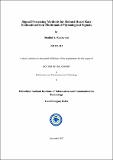Please use this identifier to cite or link to this item:
http://drsr.daiict.ac.in//handle/123456789/651| Title: | Signal processing methods for robust heart rate estimation from multimodal physiological signals |
| Authors: | Dubey, Rahul Rankawat, Shalini A. |
| Keywords: | Multimodal physiological signals Cardiac Arrhythmia Cardiovascular Signals Electroencephalogram Noise and Artifacts Heart beat detection Robust heart beat detection |
| Issue Date: | 2017 |
| Publisher: | Dhirubhai Ambani Institute of Information and Communication Technology |
| Citation: | Shalini A. Rankawat(2017).Signal Processing Methods for Robust Heart Rate Estimation from Multimodal Physiological Signals.Dhirubhai Ambani Institute of Information and Communication Technology.xvii, 205 p.(Acc.No: T00673) |
| Abstract: | Cardiovascular diseases are the major cause of world-wide mortality. Heart rate (HR) and heart rate variability (HRV) are important health parameters to monitor functioning of heart of cardiac patients. Multimodal physiological signals namely; Electrocardiogram, Arterial Blood Pressure, Photoplethysmogram, Electroencephalogram, Electrooculogram, Electromyogram etc. are recorded in ICU for close monitoring of vital health parameters of critically ill patients. However, Electrocardiogram (ECG), that provides direct measure of heart rate, is often corrupted by noise or is missing and the heart rate estimated from such signals would be erroneous. Thus, there is a need for development of methods for robust heart rate estimation especially when ECG is either noisy or missing. This thesis investigates the development of appropriate signal processing techniques for robust heart rate estimation from fusion of cardiovascular signals with non-cardiovascular (NC) signals that are not related to cardiac activities but contain some markers of heart beats. The signals used in proposed study are ECG, Arterial Blood Pressure (ABP), Electroencephalogram (EEG), Electro-oculogram (EOG) and Electromyogram (EMG). A novel slope sum function and Teager-Kaiser Energy (SSF-TKE) method is developed for ECG artifacts detection in NC signals. It requires neither additional ECG channel nor apriori user input. Results from evaluation on standard databases have shown that SSF-TKE method is a highly effective technique for R-peak artifacts detection in non-cardiovascular signals contaminated with ECG artifacts. The use of SSF-TKE method is then explored in R-peak detection in ECG signal. SSFTKE is a simple method for R-peak detection that does not consider detail morphology ofECG, except steep slopes, amplitude and periodicity of QRS complex. This method has achieved excellent R-peak detection performance across a number of standard databases with variety of signal morphology. Experiments have demonstrated that SSF-TKE algorithm is highly resistance to different types of ECG noises and its beat detection performance is superior to well known QRS detectors, 'gqrs' and 'epltd' in noisy signals and in ECG signals with pacemaker beats. A new statistical and rhythm based beat SQI method has been developed for assessment of signal quality of cardiovascular and non-cardiovascular signals. It is based on rhythm of detected heart beats and probability of the beat being a matched beat. The proposed beat SQI is a simple method of signal quality assessment and it requires only one beat detector. It is shown that signal classification accuracy of beat SQI is better than that of bSQI, a well known SQI assessment method, which requires two independent QRS detectors. Beat SQI works satisfactorily on bradycardia, tachycardia and signals with different types of arrhythmias, except on certain types of rrhythmias like atrial fibrillation, ventricular bigeminy and atrial ectopic. Beat SQI has enabled effective participation of non-cardiovascular signals in the voting fusion process. A novel voting fusion method is presented for robust heart beat detection and heart rate estimation from fusion of multimodal physiological signals i.e. cardiovascular signals and non-cardiovascular signals. The proposed fusion method is based on weighting the beats from each signal according to the corresponding SQI of the beats, assessed by the beat SQI method. The evaluation results of beat SQI based majority fusion method for robust heart beat detection on different standard databases are presented and compared with other methods. The results show that fusion improves overall score of beat detection as compared to that achieved by individual well known detectors. The proposed algorithm for beat detection has also been evaluated on PhysioNet/CinC Challenge 2014 hidden test dataset by submitting it in PhysioNet web server and presently the algorithm ranks fifth in results from the 2014 challenge. The beat SQI based voting fusion method has been evaluated on standard databases for robust heart rate estimation from fusion of multimodal signals. The fusion method provides a significantly better estimate of heart rate than heart rate estimate derived from a single signal. The proposed method has been validated on concurrent noisy cardiovascular signals (ECGand ABP) of a synthetic noise dataset, generated by adding different types of calibrated noise in clean signals, to assess participation of non-cardiovascular signals in majority voting fusion for robust heart beat as well as heart rate estimation. The results on noise evaluation dataset show that proposed voting fusion method has significantly improved accuracy of heart rate estimate as compared to that obtained from single cardiovascular signal, even when both ECG and ABP signals are extremely noisy concurrently. It demonstrates effective participation of non-cardiovascular signals in voting fusion for robust heart rate estimation and NC signals have increased robustness of the system. The proposed algorithm has been implemented on Raspberry Pi 3 and its computation time is 75 times faster than the required constraints for real time applications. The asymptotic runtime complexity analysis of our algorithm is O(N), where 'N' is the number of samples inthe signal. |
| URI: | http://drsr.daiict.ac.in//handle/123456789/651 |
| Appears in Collections: | PhD Theses |
Files in This Item:
| File | Description | Size | Format | |
|---|---|---|---|---|
| 201121012.pdf | 201121012 | 5.86 MB | Adobe PDF |  View/Open |
Items in DSpace are protected by copyright, with all rights reserved, unless otherwise indicated.
